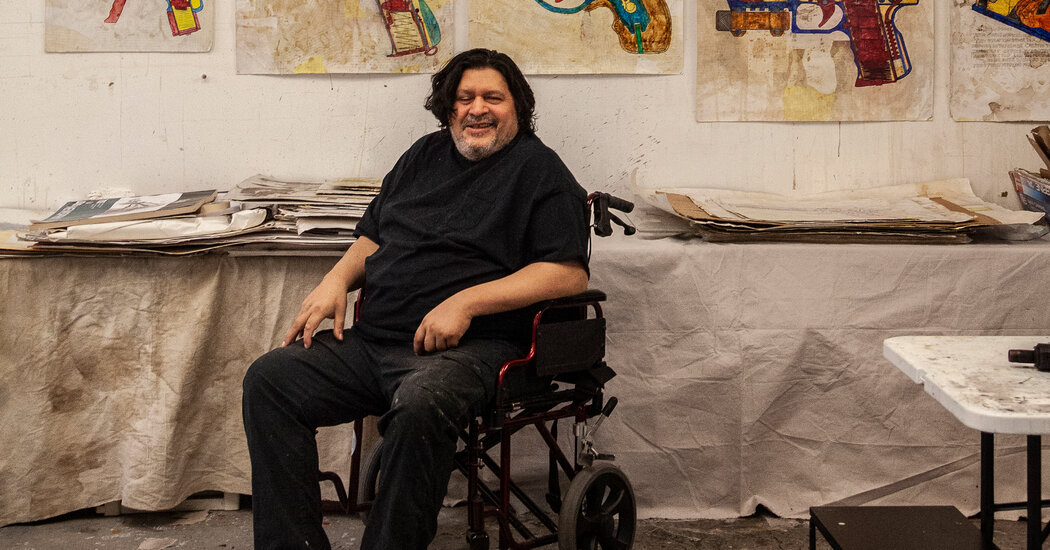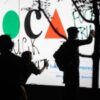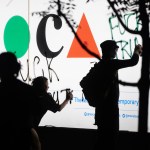
Alfredo Martinez lived on New York City’s margins. He was an artist who usually lacked a gallery and who put on exhibits in a storage locker. He lived as a squatter, shaking off one eviction after another.
Yet Mr. Martinez was also a player in the world capital of culture and media.
He mastered a few artistic techniques. He had the chutzpah to break the rules. He saw that criminality was a neighbor of fame. And he talked in the colorful manner that makes journalists listen.
Mr. Martinez synthesized those qualities into an idiosyncratic strategy for the bohemian provocateur: Use prison to supercharge an art career. He did that in the early 2000s, after he pleaded guilty to art forgery. And with his guidance, Anna Sorokin transformed herself from a celebrity scammer being held in an immigration detention facility into an artist selling pencil and acrylic drawings for $10,000 a pop.
It was one of many ways Mr. Martinez brought together New York’s art world and underworld.
He died on Aug. 21 at his home in Newark, where he had moved recently seeking space and stability, Mr. Martinez’s brother, Javier, said. He was 56. He suffered from diabetes and an infection in his right leg that led to a series of amputations, beginning with his big toe and culminating above the knee.
Mr. Martinez’s education in staging transgressive, carnivalesque art spectacles began in his late 20s and 30s.
In 1999, the tech mogul Josh Harris offered dozens of arty acquaintances a month of room and board in a downtown Manhattan bunker in exchange for the right to film everything they did. There was sex, drugs, military-style interrogations and, surreally, a well-stocked arsenal of guns and a shooting range. Mr. Martinez, credited as the “artillery artist,” set that up.
(His role in the project was later recorded in “We Live in Public,” a documentary by Ondi Timoner.)
Around the same time, Mr. Martinez was curating group art shows, generally drawing work from artists he knew and using ersatz galleries that did not outlive the shows themselves. In 2000, one exhibit, “Na’er Do Wells,” featured some unusually valuable objects: a drawing and a painted chair back by Jean-Michel Basquiat.
Basquiat’s art gave Mr. Martinez an idea.
“I just knew instinctively it was something I could forge,” he told The Village Voice in 2007. “It was such an easy way to make a quick 20 grand.”
Using the Basquiats that appeared in “Na’er Do Wells” and their authentication papers as models, Mr. Martinez began a forgery operation. He sold two fake Basquiats to the New York art dealer Lio Malca, Artnet reported, and he approached two other dealers with offers.
That led to his arrest. Mr. Martinez pleaded guilty to wire fraud, according to Artnet. He was sentenced to more than two years in prison.
Mr. Martinez saw the punishment as an opportunity. “Jail,” he was fond of telling journalists in the years to come, “was a publicity stunt.”
During his trial and imprisonment, he became a figure on Page Six of The New York Post. In October 2003, the gossip column reported, Mr. Martinez “managed to smuggle his jailhouse art — painted using coffee, Kool-Aid and fruit juice — to a Chelsea gallery,” called the Proposition Gallery. The listed price of his works: $150,000.
In January the next year, New York magazine followed up the story. The writer and art critic Anthony Haden-Guest reported that Mr. Martinez’s work had appeared in four shows, including solo exhibitions in New York and Paris.
His prison works included cartoonish but detailed drawings of guns and a portrait of himself on hunger strike strapped to a gurney preparing to be force-fed.
Many years after his release, Mr. Martinez was still trading on the glamour of his crime, introducing himself to a journalist from Insider by saying, “I’m a notorious art forger.”
By then, Mr. Martinez had found a new opportunity for his art-crime hucksterism.
In May 2020, Anna Sorokin was in the midst of a 4-to-12-year prison sentence for financial crimes. She had been the subject of magazine profiles, tabloid gossip and news coverage for posing as a German heiress named Anna Delvey and swindling banks, hotels and associates out of about $200,000. Now she had begun doing something new: having her friends post self-portraits on Instagram that she had drawn in prison.
Julia Morrison, a friend of Mr. Martinez’s and a fellow artist, showed him Ms. Sorokin’s work, pointing out that, like Mr. Martinez, she was a con artist turned artist.
Ms. Morrison and Mr. Martinez tried reaching out to Ms. Sorokin.
“It was impossible to get ahold of her,” Mr. Martinez told Insider. “So what I did was, I planted some story in Page Six to get her attention.”
In March 2021, while Ms. Sorokin was on parole, Page Six announced that “noted artist and curator Alfredo Martinez” had “fallen in love” with Ms. Sorokin’s drawings.
Now Ms. Sorokin replied to Ms. Morrison and Mr. Martinez. The group began planning an exhibit.
Days after the Post article came out, Immigration and Customs Enforcement took Ms. Sorokin into custody for overstaying her visa. She faced the same difficulty Mr. Martinez once had in making art while incarcerated. He came up with a solution: printing out images of her works and copying them, using the same tracing method with which he had forged Basquiat.
On March 17 last year — soon after the release of “Inventing Anna,” a Netflix mini-series about Ms. Sorokin — a crowd of skateboarders, party people, curiosity seekers, contemporary art fans and journalists gathered in a shuttered downtown Manhattan storefront. It was a classic Alfredo Martinez group show and art spectacle.
“Free Anna Delvey!” the crowd chanted.
Ms. Sorokin called Mr. Martinez. He put her on speaker and held his phone aloft. Ms. Morrison told the crowd to shut up and listen.
Mr. Martinez smiled. Once again, he had New York’s attention.
Alfredo Martinez was born on April 15, 1967, in Brooklyn, to Alfredo and Sonia (Pereyra) Martinez. The family ran a junk store in Brooklyn, and they lived behind the store. Alfredo ran away from home as a teenager.
In addition to his brother, Mr. Martinez is survived by his father and two sisters, Sonia and Christine Martinez.
Some who followed Mr. Martinez’s career called him a publicity hound. Curators asking around about him got the advice to stay away. Even friends like Ms. Morrison often found themselves feeling exploited.
But it’s not hard to find people eager to discuss not only Mr. Martinez’s chicanery and showmanship, but also his artwork itself.
One of Mr. Martinez’s preoccupations was making aluminum casts of pistols, revolvers and machine guns, among other techniques for using gun parts to create menacing yet toylike sculptures. In a phone interview, Mr. Haden-Guest called them “genuinely peculiar and unusual.”
He added that Mr. Martinez might turn out to fit a familiar type: the troublemaker who posthumously finds renown.
“An artist with an unruly kind of life, a street life, who people find hard to accept in their lives — bang, when they’re dead, they’re there,” he said. “They’re part of art history.”
Kirsten Noyes contributed research.
This post was originally published on this site be sure to check out more of their content.






